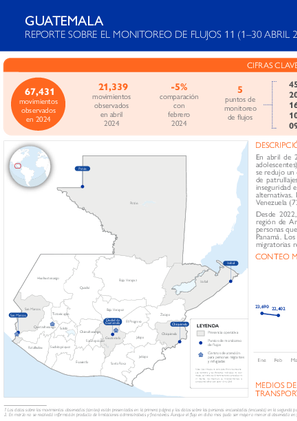-
Countries
-
Data and Analysis
-
Special Focus
-
Crisis Responses
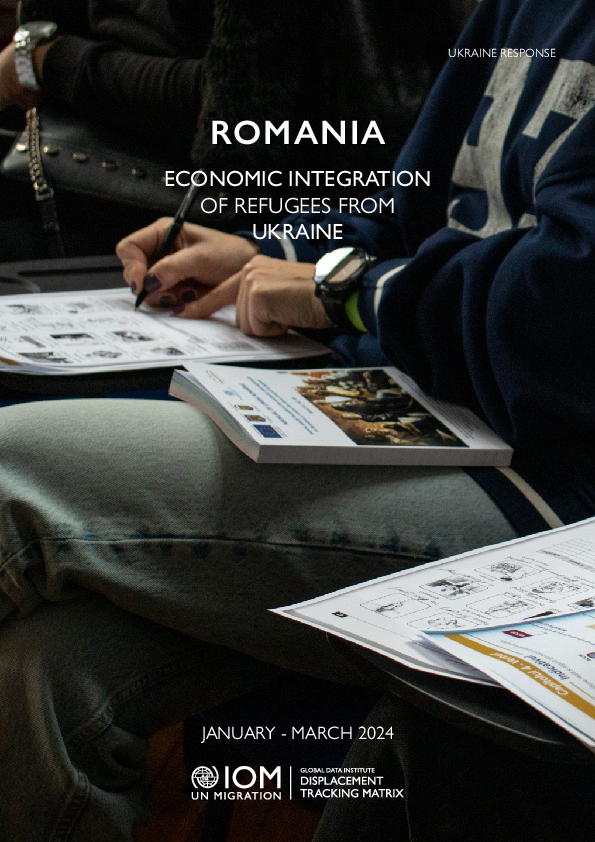
Contact
DTM Europe, DTMMediterranean@iom.int
Language
English
Location
Romania
Period Covered
Jan 01 2024
Mar 31 2024
Activity
- Survey
- Flow Monitoring
IOM’s Displacement Tracking Matrix (DTM) collected data through Surveys with Refugees in the Ukraine Response region from January to March 2024. This report focuses on the economic integration of the Ukrainian nationals residing in Romania since the start of the war in February 2022. The survey reported on the situation of 436 interviewed Ukrainian nationals, with a focus on the respondents of working age (18-64 years old).
Key findings:
- 60% of respondents were active in the labour market, while 35% were inactive and 5% were unknown
- Within the active population, 65% were employed and 35% were unemployed and looking for a job
- Most respondents utilised their personal network to find employment (43%). Others utilised: recruitment agencies (19%), social media (14%), job portals (11%).
- 43% of respondents had neutral feelings towards their job satisfaction
- Majority of respondents identified no problems at work (51%). For those who did, the main problems included: being underpaid (4%), having no contract (4%), working long hours (4%), and no breaks (3%).
- Top 3 sources for paying expenses included: family support (46%), income (41%), and savings (35%).

Contact
DTM Europe, DTMMediterranean@iom.int
Language
Estonian
Location
Estonia
Period Covered
Mar 01 2023
Dec 31 2023
Activity
- Survey
- Flow Monitoring
IOMi sundrände jälgimise maatriks on regulaarselt küsitlenud inimesi, kes elavad 11 riigis, mida hõlmab Ukraina piirkondliku pagulasküsimuse tegevuskava. Küsitluse eesmärk on parandada arusaamist nende profiilidest, sundrändemustritest, kavatsustest ja vajadustest. Küsitlust tehakse kuues Ukraina naaberriigis –Valgevenes, Ungaris, Poolas, Moldova Vabariigis, Rumeenias ja Slovakkias –ning viies teises Euroopa riigis, mida Ukrainast pärit pagulaste saabumine alates sõja algusest 2022. aasta veebruaris iseäranis mõjutab, sealhulgas Bulgaarias, Tšehhis, Eestis, Lätis ja Leedus.
Käesolevas aruandes esitatud analüüs põhineb 2023. aasta märtsist detsembrini kogutud iga-aastastel andmetel.
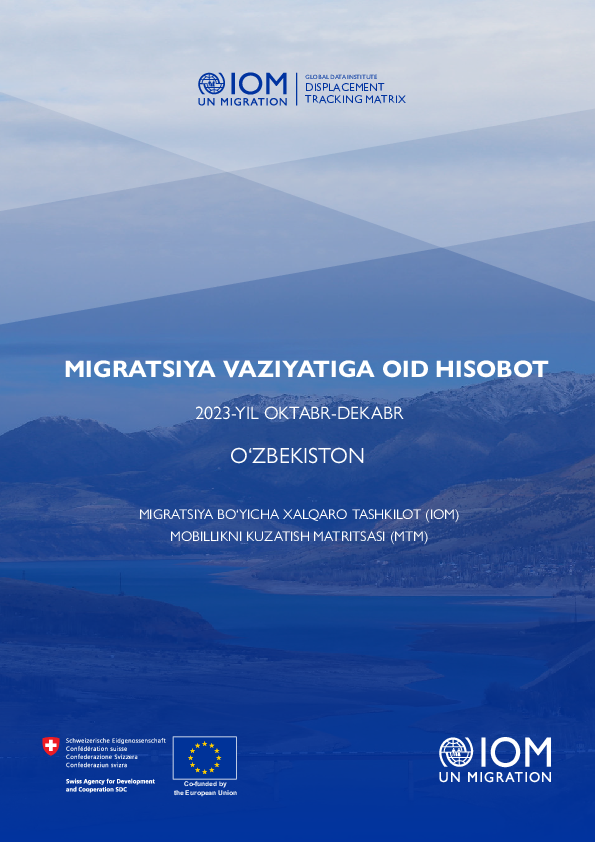
Contact
iomtashkent@iom.int
Language
English
Location
Uzbekistan
Period Covered
Oct 01 2023
Dec 31 2023
Activity
- Flow Monitoring Survey
- Mobility Tracking
Ushbu hisobot 2023-yil oktabr-dekabr oylari uchun mavjud ochiq maʼlumotlarga asoslanib, O‘zbekistondagi migratsiya muammolariga oid so‘nggi jarayonlar bo‘yicha maʼlumotlarni taqdim etadi hamda jamoatchilikka ochiq bo‘lgan milliy va xalqaro maʼlumotlar to‘plami asosida butun o‘tgan yil uchun migratsiya jarayonlariga oid asosiy xulosalarni keltiradi. Hisobot mamlakatdagi migratsiya vaziyatiga sezilarli ta’sir ko‘rsatgan so‘nggi yirik global va mintaqaviy voqealarni o‘z ichiga oladi. Rossiyaning Ukrainaga bosqini davom etishi hamda buning natijasida an’anaviy migratsiya yo‘laklari, mehnat migratsiyasi oqimining o‘zgarishi, iqlim o‘zgarishi va migratsiya xavotirlarining kuchayishi, o‘sib borayotgan urbanizatsiya jarayoni, ijtimoiy-iqtisodiy sharoitlar, tartibsiz migratsiya jarayonlarining kuchayishi va boshqa muhim voqealar mamlakatdagi ushbu davrda insonlar mobilligi va migratsiya harakatining asosiy omili sifatida tavsiflangan. Shuningdek, hisobot ushbu davrda O‘zbekistonda IOM tomonidan taqdim etilgan migratsiya ma’lumotlari bo‘yicha malaka oshirish sessiyalari haqida to‘xtalib, mazkur yo‘nalishdagi sa’yi-harakatlarni yoritadi.
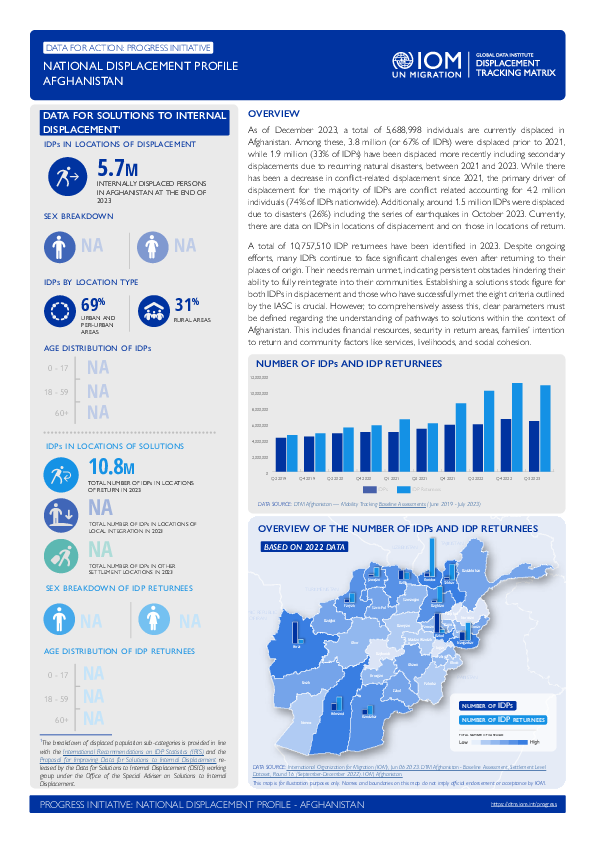
Contact
DTMAfghanistan@iom.int
Language
English
Location
Afghanistan
Period Covered
Jan 01 2023
Dec 31 2023
Activity
- Survey
- Displacement Solutions
Following the release of the first edition of PROGRESS 2023 report, the Displacement Tracking Matrix (DTM) has compiled a series of National Displacement Profiles based on end of year 2023 figures. These profiles offer insights into the latest end-of-year 2023 figures, aligning with the objectives outlined by the Data for Solutions to Internal Displacement Taskforce (DSID).
The profile provides a comprehensive overview of the demographic breakdowns and geographical distribution of internally displaced persons (IDPs) in Afghanistan as of the end of 2023. It delves into the primary areas of origin and displacement for IDPs, shedding light on the factors influencing their decision-making processes regarding the selection of solutions locations. Additionally, the report discusses the obstacles encountered by IDPs in their pursuit of durable solutions.
This compilation underscores the critical role of data in addressing internal displacement challenges and highlights the ongoing efforts to leverage data-driven solutions through collaborative initiatives like DSID.
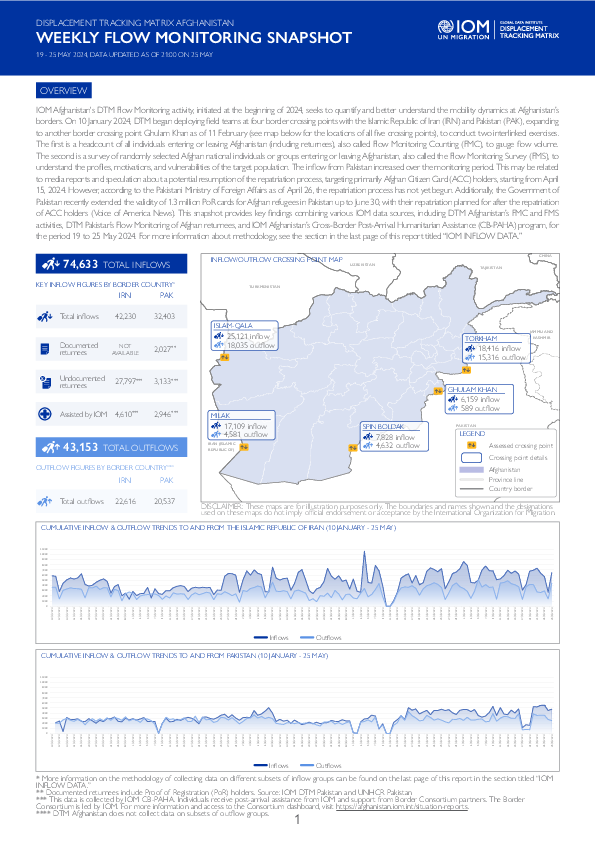
Contact
DTMAfghanistan@iom.int
Language
English
Location
Afghanistan
Period Covered
May 19 2024
May 25 2024
Activity
- Survey
- Flow Monitoring Survey
- Flow Monitoring
IOM Afghanistan's DTM Flow Monitoring activity, initiated at the beginning of 2024, seeks to quantify and better understand the mobility dynamics at Afghanistan’s borders. On 10 January 2024, DTM began deploying field teams at four border crossing points with the Islamic Republic of Iran (IRN) and Pakistan (PAK), expanding to another border crossing point Ghulam Khan as of 11 February (see map below for the locations of all five crossing points), to conduct two interlinked exercises. The first is a headcount of all individuals entering or leaving Afghanistan (including returnees), also called Flow Monitoring Counting (FMC), to gauge flow volume. The second is a survey of randomly selected Afghan national individuals or groups entering or leaving Afghanistan, also called the Flow Monitoring Survey (FMS), to understand the profiles, motivations, and vulnerabilities of the target population. The inflow from Pakistan increased over the monitoring period. This may be related to media reports and speculation about a potential resumption of the repatriation process, targeting primarily Afghan Citizen Card (ACC) holders, starting from April 15, 2024. However, according to the Pakistani Ministry of Foreign Affairs as of April 26, the repatriation process has not yet begun. Additionally, the Government of Pakistan recently extended the validity of 1.3 million PoR cards for Afghan refugees in Pakistan up to June 30, with their repatriation planned for after the repatriation of ACC holders (Voice of America News). This snapshot provides key findings combining various IOM data sources, including DTM Afghanistan’s FMC and FMS activities, DTM Pakistan’s Flow Monitoring of Afghan returnees, and IOM Afghanistan’s Cross-Border Post-Arrival Humanitarian Assistance (CB-PAHA) program, for the period 19 to 25 May 2024. For more information about methodology, see the section in the last page of this report titled “IOM INFLOW DATA.”
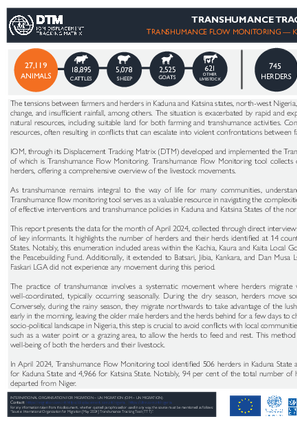
Contact
DTM Nigeria, iomnigeriadtm@iom.int
Language
English
Location
Nigeria
Period Covered
Apr 01 2024
Apr 30 2024
Activity
- Flow Monitoring
This report presents the data for the month of April 2024, collected through direct interviews and direct observation by DTM enumerators and triangulated via a network of key informants. It highlights the number of herders and their herds identified at 14 counting points in 7 Local Government Areas (LGAs) across Kaduna and Katsina States. Notably, this enumeration included areas within the Kachia, Kaura and Kaita Local Government Areas (LGAs) of Kaduna and Katsina states, under the auspices of the Peacebuilding Fund. Additionally, it extended to Batsari, Jibia, Kankara, and Dan Musa LGAs of Katsina state, which were supported by the European Union Fund.
Faskari LGA did not experience any movement during this period.
In April 2024, Transhumance Flow Monitoring tool identified 506 herders in Kaduna State and 239 herders in Katsina State. The animal count was estimated at 22,153 for Kaduna State and 4,966 for Katsina State. Notably, 94 per cent of the total number of herders departed from states within Nigeria, while the remaining 6 per cent departed from Niger.
Contact
DTM Yemen, iomyemendtm@iom.int
Location
Yemen
Activity
- Mobility Tracking
- Event Tracking
Period Covered
May 26 2024 -Jun 01 2024
From 1 January to 1 June 2024, IOM Yemen DTM tracked 1,465 households (HH) (8,790 Individuals) who experienced displacement at least once.
Between 26 May and 1 June 2024, IOM Yemen DTM tracked 57 households (342 individuals) displaced at least once. The majority of people moved into/within the following governorates and districts:
- Ma’rib (38 HHs) – Ma’rib City (19 HHs), Ma’rib (14 HHs), Harib (5 HHs) districts. Most displacements in the governorate originated from Ta’iz and Al Hodeidah.
- Shabwah (8 HHs) – Bayhan (8 HHs) district. All displacements in the governorate originated from Al Bayda.
- Ta’iz (6 HHs) – Al Makha (3 HHs), Al Misrakh (2 HHs), Jabal Habashi (1 HH) districts. Most displacements in the governorate originated from Ta’iz and Al Hodeidah.
The majority of people moved from the following governorates and districts:
- Ta’iz (12 HHs) – Mawza (3 HHs), As Silw (3 HHs), Maqbanah (1 HH) districts.
- Al Hodeidah (9 HHs) – Ad Durayhimi (2 HHs), Az Zuhrah (1 HH), Jabal Ras (1 HH) districts.
- Al Bayda (8 HHs) – Numan (4 HHs), Nati (4 HHs) districts.
Population Groups
IDPs
Returnee (Previously Internally Displaced)
Survey Methodology
Unit of Analysis Or Observation
Admin Area 2
Household
Site or Location
Type of Survey or Assessment
Household
Key Informant
Keywords
Geographical Scope Partial Coverage
Administrative boundaries with available data
The current dataset covers the following administrative boundaries
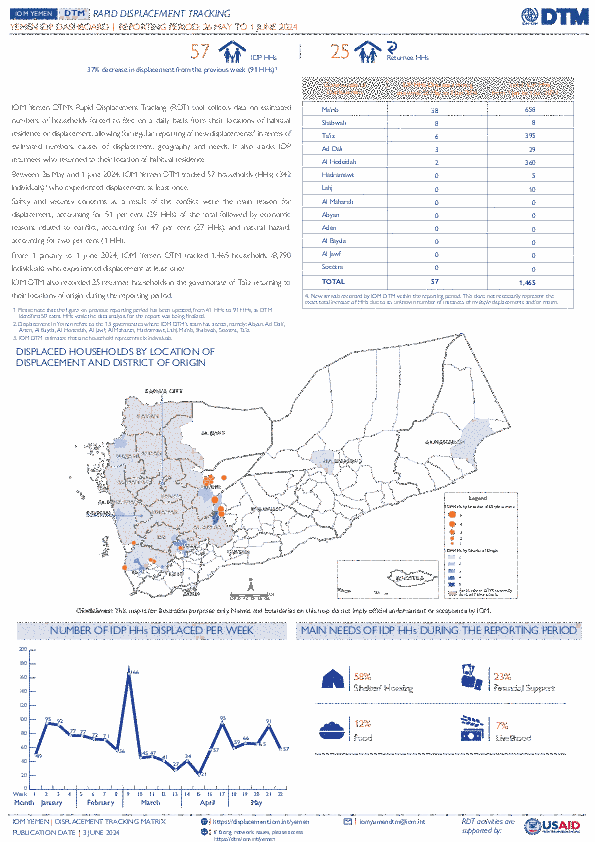
Contact
DTM Yemen, iomyemendtm@iom.int
Language
English
Location
Yemen
Period Covered
May 26 2024
Jun 01 2024
Activity
- Mobility Tracking
- Event Tracking
IOM Yemen DTM’s Rapid Displacement Tracking (RDT) tool collects data on estimated numbers of households forced to flee on a daily basis from their locations of origin or displacement, allowing for regular reporting of new displacements in terms of estimated numbers, geography, and needs. It also tracks returnees who returned to their location of origin.
From 1 January to 1 June 2024, IOM Yemen DTM tracked 1,465 households (HH) (8,790 Individuals) who experienced displacement at least once.
Between 26 May and 1 June 2024, IOM Yemen DTM tracked 57 households (342 individuals) displaced at least once. The majority of people moved into/within the following governorates and districts:
- Ma’rib (38 HHs) – Ma’rib City (19 HHs), Ma’rib (14 HHs), Harib (5 HHs) districts. Most displacements in the governorate originated from Ta’iz and Al Hodeidah.
- Shabwah (8 HHs) – Bayhan (8 HHs) district. All displacements in the governorate originated from Al Bayda.
- Ta’iz (6 HHs) – Al Makha (3 HHs), Al Misrakh (2 HHs), Jabal Habashi (1 HH) districts. Most displacements in the governorate originated from Ta’iz and Al Hodeidah.
The majority of people moved from the following governorates and districts:
- Ta’iz (12 HHs) – Mawza (3 HHs), As Silw (3 HHs), Maqbanah (1 HH) districts.
- Al Hodeidah (9 HHs) – Ad Durayhimi (2 HHs), Az Zuhrah (1 HH), Jabal Ras (1 HH) districts.
- Al Bayda (8 HHs) – Numan (4 HHs), Nati (4 HHs) districts.
IOM identified 50 additional households displaced in the previous reporting period, which covered 19 - 25 May 2024, in the governorates of Ta’iz (35 HHs), Ma’rib (11 HHs), and Al Hodeidah (4 HHs). These figures have been added to the cumulative displacement total recorded since the beginning of the year.
En abril de 2024 se observaron 21,339 movimientos en Guatemala (16% niños, niñas y adolescentes) y 394 personas fueron encuestadas.1 El número de movimientos observados se redujo un cinco por ciento desde febrero2 de 2024 (22,402). Esto producto del aumento de patrullajes a lo largo de la frontera entre México y Guatemala, así como una mayor inseguridad en algunas partes de Guatemala, lo que empuja a los migrantes a utilizar rutas alternativas. Más de la mitad de los movimientos procedía de la República Bolivariana de Venezuela (72%). El principal destino previsto fue los Estados Unidos de América (91%). Desde 2022, los flujos de migrantes en tránsito incrementaron significativamente en la región de América Latina y el Caribe, observando cantidades nunca antes registradas de personas que cruzan la peligrosa selva del Parque Nacional del Darién desde Colombia hacia Panamá. Los flujos en tránsito observados en Guatemala han reflejado dichas tendencias migratorias regionales.

Contact
iomguatemala@iom.int
Language
English
Location
Guatemala
Period Covered
Apr 01 2024
Apr 30 2024
Activity
- Flow Monitoring
In April 2024, 21,339 movements were observed in Guatemala (16% children) and 394 individuals were surveyed.1 The number of observed movements decreased by five per cent from February2 2024 (22,402). This is a result of the increase in patrols along the Mexico–Guatemala border as well as increased insecurity in some parts of Guatemala, pushing migrants to use alternative routes.More than half of movements originated from the Bolivarian Republic of Venezuela (72%). The main intended destination was the United States of America (91%). Since 2022, migratory flows through the Latin America and Caribbean region have increased significantly, with record levels of persons crossing the perilous jungle of the Darién National Park from Colombia into Panama. The in-transit flows tracked in Guatemala have mirrored these regional migration trends.
